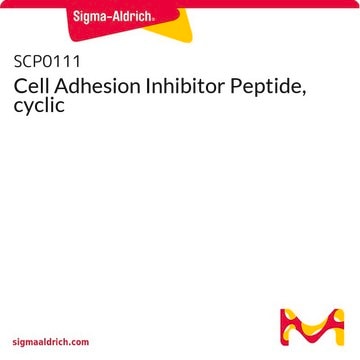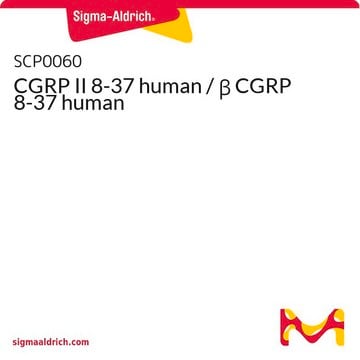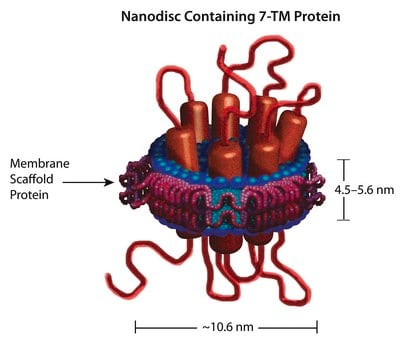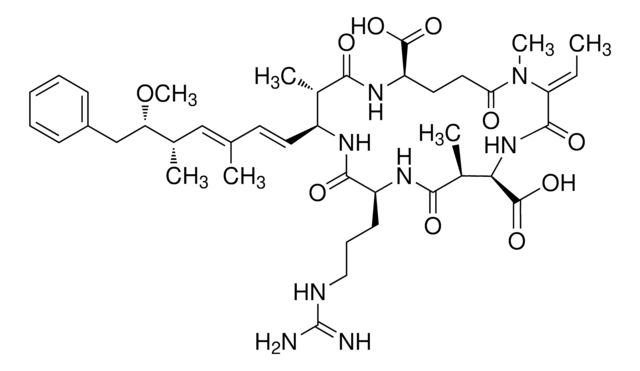SCP0061
Calcitonin Gene Related Peptide II, cyclic human
Iniciar sesiónpara Ver la Fijación de precios por contrato y de la organización
About This Item
Fórmula empírica (notación de Hill):
C162H267N51O48S3
Peso molecular:
3793.36
Código UNSPSC:
51111800
NACRES:
NA.32
Productos recomendados
Ensayo
≥95% (HPLC)
Formulario
lyophilized
composición
Peptide Content, ≥75%
condiciones de almacenamiento
protect from light
temp. de almacenamiento
−20°C
Amino Acid Sequence
Ala-Cys-Asn-Thr-Ala-Thr-Cys-Val-Thr-His-Arg-Leu-Ala-Gly-Leu-Leu-Ser-Arg-Ser-Gly-Gly-Met-Val-Lys-Ser-Asn-Phe-Val-Pro-Thr-Asn-Val-Gly-Ser-Lys-Ala-Phe-NH2
Aplicación
Calcitonin Gene Related Peptide II (CGRP-II) is a member of the calcitonin gene family used to study CGRP receptor specificity and function and CGRP signaling.
Código de clase de almacenamiento
11 - Combustible Solids
Clase de riesgo para el agua (WGK)
WGK 3
Punto de inflamabilidad (°F)
Not applicable
Punto de inflamabilidad (°C)
Not applicable
Elija entre una de las versiones más recientes:
Certificados de análisis (COA)
Lot/Batch Number
¿No ve la versión correcta?
Si necesita una versión concreta, puede buscar un certificado específico por el número de lote.
¿Ya tiene este producto?
Encuentre la documentación para los productos que ha comprado recientemente en la Biblioteca de documentos.
S J Wimalawansa
Critical reviews in neurobiology, 11(2-3), 167-239 (1997-01-01)
The calcitonin gene peptide superfamily consists of calcitonin (CT), calcitonin gene-related peptide (CGRP), and amylin. CT and CGRP derive from the CT/CGRP gene, which is encoded on chromosome 11. Alternative splicing of the primary RNA transcript leads to the translation
Philippe Linscheid et al.
Endocrinology, 146(6), 2699-2708 (2005-03-12)
Human adipose tissue is a contributor to inflammation- and sepsis-induced elevation of serum procalcitonin (ProCT). Several calcitonin (CT) peptides, including ProCT, CT gene-related peptide (CGRP), and adrenomedullin (ADM) are suspected mediators in human inflammatory diseases. Therefore, we aimed to explore
D Naot et al.
Bone, 43(5), 813-818 (2008-08-09)
The 'calcitonin family' is a group of peptide hormones that share structural similarities with calcitonin, and includes calcitonin gene-related peptide (CGRP), amylin, adrenomedullin and adrenomedullin 2 (intermedin). These hormones are produced by different tissues, with calcitonin being produced in thyroid
Sophie C Egea et al.
Endocrinology, 153(4), 1850-1860 (2012-02-09)
Calcitonin gene-related peptide (CGRP) is a neuropeptide with multiple neuroendocrine roles, including vasodilation, migraine, and pain. The receptor for CGRP is a G protein-coupled receptor (GPCR) that requires three proteins for function. CGRP binds to a heterodimer composed of the
Ramiro E Toribio et al.
Molecular and cellular endocrinology, 199(1-2), 119-128 (2003-02-13)
In this study, we describe the cloning and tissue expression of equine calcitonin (CT), calcitonin-gene related peptide (CGRP)-I, and CGRP-II cDNA. We also describe a novel divergent form of CGRP (CGRP-I). Equine CT has greatest homology (>85%) to human, rat
Nuestro equipo de científicos tiene experiencia en todas las áreas de investigación: Ciencias de la vida, Ciencia de los materiales, Síntesis química, Cromatografía, Analítica y muchas otras.
Póngase en contacto con el Servicio técnico







